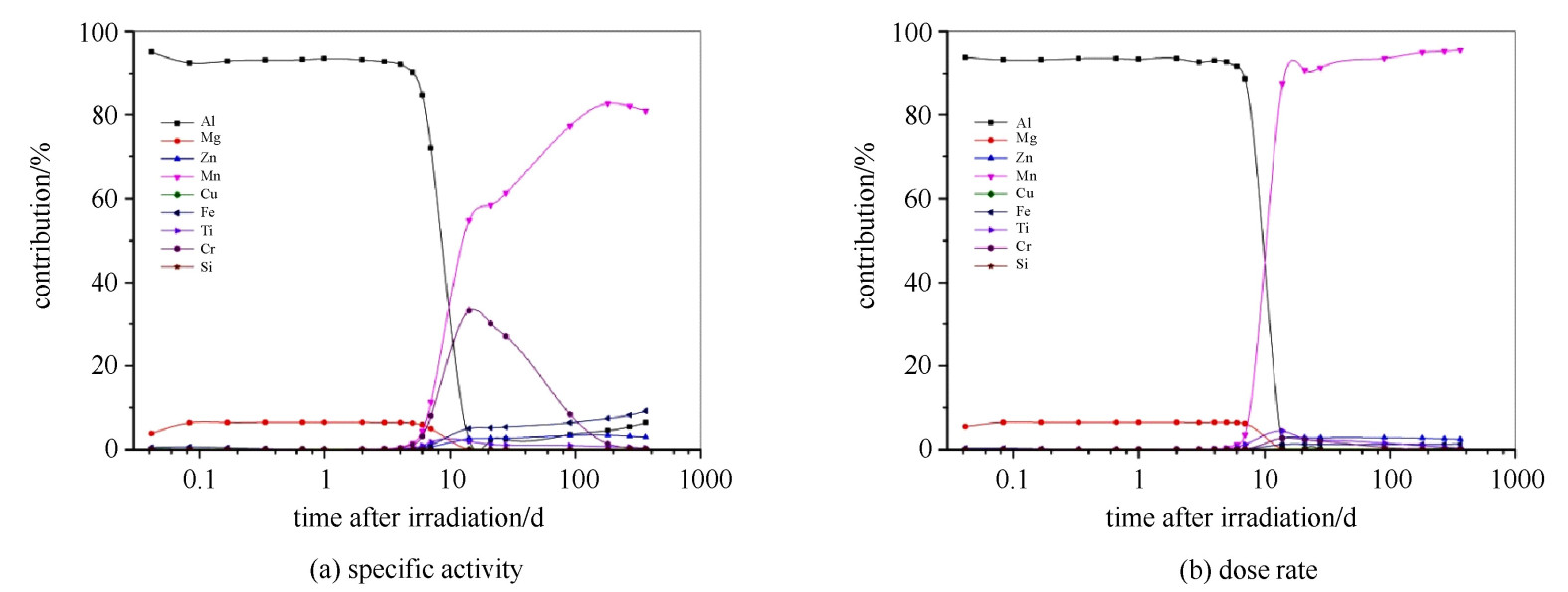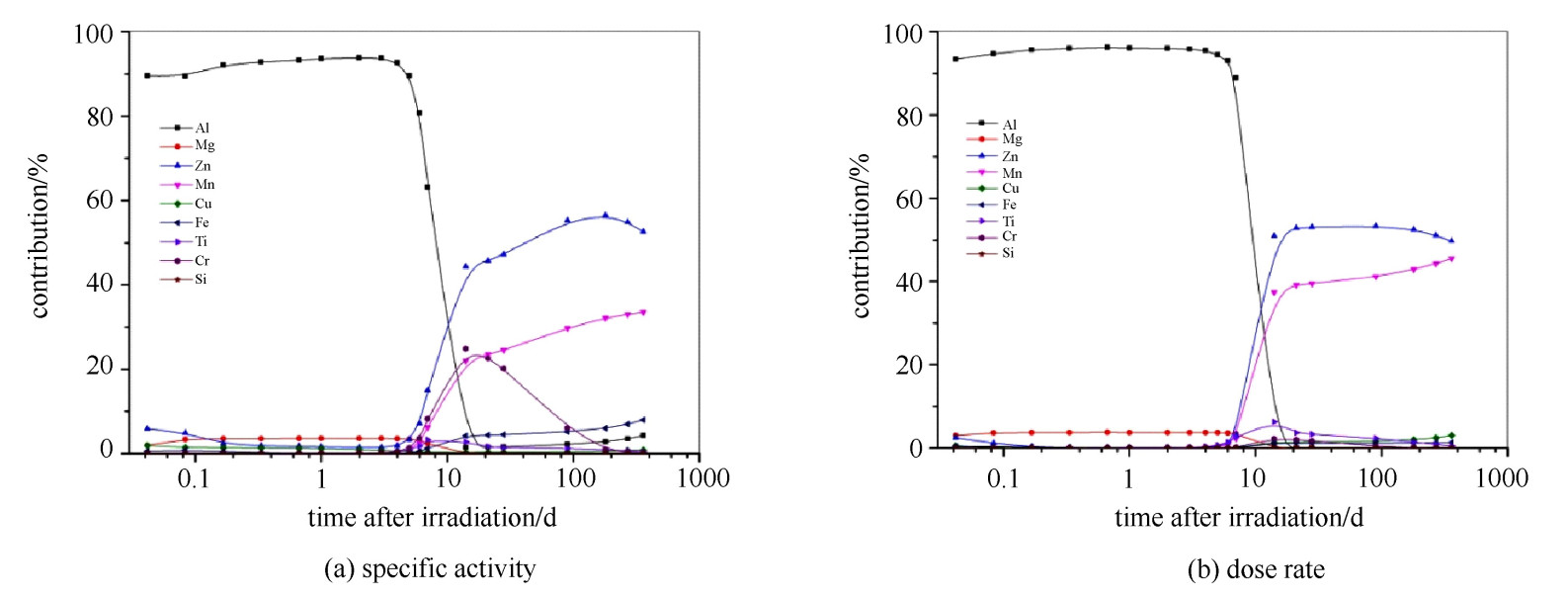Analysis of activation characteristics of aluminum alloy irradiated by 14 MeV neutrons
-
摘要: 铝合金是激光惯性约束聚变(ICF)装置中最常用的结构材料之一,将直接受到高能量、高产额的中子辐照。评估铝合金材料在14 MeV中子辐照下的活化特性,可为我国ICF装置的材料选取提供参考。采用FISPACT活化计算软件,计算并比较了三种不同牌号的铝合金材料在14 MeV中子辐照后产生的比活度和剂量率,并分析了不同元素对比活度和剂量率的贡献。结果表明,铝合金的比活度和剂量率在冷却一周之内下降了3个数量级。铝合金的活化主要来自Al元素、Mn元素和Zn元素,主要活化产物为24Na, 54Mn和65Zn。Al元素在冷却一周内对比活度(剂量率)的贡献大于90%,其余两种元素在两周之后占主导作用,其贡献之和超过50%。通过选取低Mn, Zn质量分数的铝合金,可降低材料在活化后的放射性水平。Abstract: Aluminum alloy, as a kind of important structural materials used in laser-driven Inertial Confinement Fusion (ICF) facilities, will be exposed to high-energy neutrons with high yields. The activation level of aluminum alloys should be taken into account when selecting the materials used in ICF facilities during design. Specific activities and dose rates for three different aluminum alloys after irradiation by 14 MeV neutrons were calculated and compared using the FISPACT inventory code. The results show that both specific activity and dose rate decrease 3 magnitudes in one week after irradiation. It is found that aluminum contributes to more than 90% of the total activity (dose rate) in the first week while Manganese and zinc in aluminum alloys are dominant in longer cooling times. The main residual nuclides are 24Na, 54Mn and 65Zn.For safety considerations, it is better to choose aluminum alloys with lower Mn and Zn contents.
-
Key words:
- fusion neutron /
- aluminum alloy /
- activation /
- activity /
- dose /
- radiation protection
-
表 1 铝合金材料各成分质量分数
Table 1. Chemical composition of aluminium alloys
material number mass fraction/% Fe Mn Si Cr Al Cu Mg Zn Ti 7075 0.50 0.60 0.40 0.28 89.62 1.20 2.10 5.10 0.20 6061 0.70 0.15 0.80 0.35 96.65 0.15 0.80 0.25 0.15 5083 0.40 1.00 0.40 0.25 93.55 0.10 4.00 0.20 0.10 表 2 主要活化产物信息
Table 2. The main radioactive products
radionuclide T1/2 decay mode gamma energy/keV main reaction channel cross section at En=14 MeV/barn 24Na 14.997 h Beta- 1368.626(99.9936)
2754.007(99.855)27Al(n, α)24Na
24Mg(n, p)24Na0.12
0.1951Cr 27.701 d E.C. 320.0824(9.910) 52Cr(n, 2n) 51Cr 0.26 55Fe 2.733 y E.C. — 56Fe(n, 2n) 55Fe 0.41 54Mn 312.05 d E.C. 834.848(99.9760) 55Mn(n, 2n) 54Mn 0.78 65Zn 243.93 d Beta+/E.C. 1115.539(50.04) 66Zn (n, 2n) 65Zn 0.60 -
[1] Moses E I. The National Ignition Facility and the National Ignition Campaign[J]. IEEE Trans Plasma Science, 2010, 38(4): 684-689. doi: 10.1109/TPS.2010.2042466 [2] Brereton S. Overview of the National Ignition Facility[J]. Health Physics, 2013, 104(6): 544-556. doi: 10.1097/HP.0b013e31828cf5cd [3] Foley R J, Karpenko V P, Adams C H, et al. Design of the target area for the National Ignition Facility[C] //The 2nd Annual International Conference on Solid State Lasers for Application to ICF, 1996. [4] Latkowski J F, Tobin M T, Singh M S. Neutronics and shielding analysis of the National Ignition Facility[C] //The 11th Topical Meeting on the Technology of Fusion Energy. 1994. [5] Sitaraman S, Brereton S, Dauffy L, et al. Post-shot radiation environment following low-yield shots inside the National Ignition Facility[R]. LLNL-CONF-461492, 2010. [6] GB/T 3190—2008, 变形铝及铝合金化学成分[S].GB/T 3190-2008. Wrought aluminum and aluminum alloy-chemical components [7] Forrest R A. FISPACT-2007: user manual[R]. Report UKAEA FUS 534, 2007. [8] Forrest R A, Kopecky J. The activation system EASY-2007[J]. Journal of Nuclear Materials, 2009, 386-388: 878-881. doi: 10.1016/j.jnucmat.2008.12.194 [9] Sidell J. EXTRA: A digital computer program for the solution of stiff sets of ordinary initial value, first order differential equations[R]. AEEW-R-799, 1976. 期刊类型引用(2)
1. 齐伟,贺书凯,崔波,张智猛,洪伟,赵宗清,谷渝秋,周维民. 超短脉冲激光驱动束靶中子源产生及应用研究进展(特邀). 中国激光. 2024(01): 92-104 .  百度学术
百度学术2. 崔波,张智猛,戴曾海,齐伟,邓志刚,黄华,贺书凯,王为武,滕建,张博,刘红杰,陈家斌,肖云青,吴笛,马文君,洪伟,粟敬钦,周维民,谷渝秋. 基于多反应通道的高产额激光中子源实验研究. 强激光与粒子束. 2021(09): 123-129 .  本站查看
本站查看其他类型引用(2)
-






 下载:
下载:






